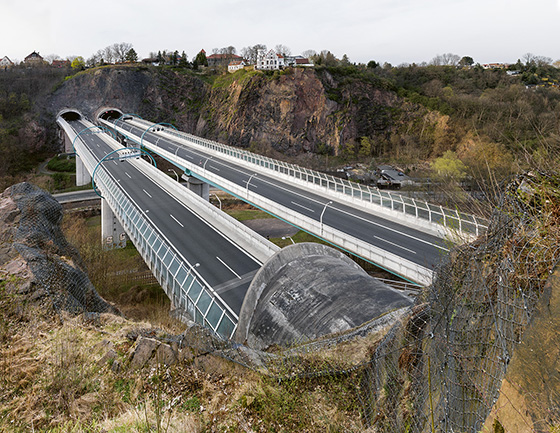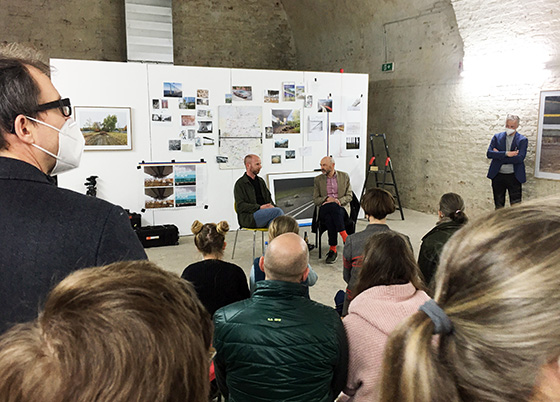Berlin Premiere
Book Launch
25.03.2022, 19.00 Uhr
Ort:
Gewölbekeller der Königstadtbrauerei
Saarbrückerstr. 24, 10405 Berlin
Eingang über die Straßburger Straße 53
(hinter den Baustellencontainern)

Die Autobahn ist ein sehr deutscher Ort – auch wenn die erste vierspurige kreuzungsfreie Schnellstraße nicht in Deutschland gebaut wurde, sondern in Italien: von Mailand in Richtung Norden nach Varese. Die Autobahn ist Ort und Unort zugleich: weil sie, einerseits, immer größere Flächen frisst. Und andererseits besteht der ganze Sinn und Zweck dieses Ortes darin, dass man hier nicht bleibt, sondern weg von hier kommt, möglichst schnell, möglichst weit (auch wenn es Momente gibt, da der leidende Fahrer glaubt, der Sinn der Autobahn bestünde darin, möglichst viele Autos zum Stillstand zu bringen, irgendwo in der deutschen Landschaft). Die Autobahn ist ein deutscher Mythos – was, auf den ersten Blick, vielleicht widersinnig klingen mag. Weil der Mythos ja eine überzeitliche Erzählung ist, eine Geschichte jenseits der Geschichte. Wogegen jeder, der sich dafür interessiert, sich über die Anfänge deutscher Autobahnen informieren kann: von der Avus, der Rennstrecke im Süden Berlins, über die Planungen einer Nord-Süd-Verbindung von Hamburg über Frankfurt nach Basel. Bis zur ersten echten Autobahn; die wurde 1932 eingeweiht; es war die heutige A 555, die links des Rheins von Bonn nach Köln führt.
Wer die mythischen Dimensionen der Autobahn überblicken will, muss die richtige Ausfahrt nehmen und von unten auf die Viadukte schauen. Michael Tewes hat das immer wieder getan, hat hinaufgeschaut, zu den Brücken, den Pfeilern, den gigantischen Bögen. Man kommt sich klein vor angesichts dieser Bilder, es packen einen die Schauder des Erhabenen (um es ein bisschen anspruchsvoll zu formulieren); man sieht auf einigen dieser Bilder sogar, dass es Kräne und Maschinen sind, die diese Werke schaffen und geschaffen haben. Aber nicht einmal der Anblick einer Brücke, die noch im Bau ist, kann den Verdacht ganz entkräften, dass es nicht Menschen, sondern Titanen sind, die solche Bauten errichten.
Dass die Autobahn, dieser ortlose Ort, zugleich ein Schauplatz ist, scheint sich von selbst zu verstehen – wer, nur zum Beispiel, mit dem Auto von Berlin nach München fährt, hat ja fünf bis sechs Stunden auf die Autobahn geschaut. Dass er nicht viel mehr gesehen hat als die Rück- und Bremslichter derer, die vor ihm fahren, das erfährt man, wenn man Tewes‘ Bilder betrachtet. Man muss anhalten, stehenbleiben, sich Zeit nehmen – die Autobahn von außen zu betrachten ist nicht nur eine Frage des Standpunkts. Sondern auch eine der Geschwindigkeit. Anhalten, stehenbleiben, das ist als Stau oder Panne definiert, allenfalls als kurze Pause. Michael Tewes betrachtet die Autobahn aus der Perspektive von nullkommanull Stundenkilometern. So wird sichtbar, was bei Tempo 130 unsichtbar bleibt.
Ach es scheint, wenn man diesen Bildern zum ersten Mal begegnet, eine Tristesse aus ihnen herauszuschauen, eine Ansicht von Deutschland als der Gegend, wo Autobahnen dringend gebaut werden mussten, damit man wegkommt von hier, möglichst weit, möglichst schnell, irgendwohin, wo die Nebel sich lichten und das Grau des Himmels sich in ein helles Blau verwandelt. Und mit jedem Kilometer Autobahn, der gebaut wird, wird das Land noch grauer und man will es noch dringender verlassen. Es ist aber ihre Tiefe, in die man hineinschauen darf, damit man Schönheit und Erhabenheit findet – und einen fast schon futuristischen Geist, der weiß, dass Grau eine elegante Farbe ist. Und dass das Grünblau einer Abdeckfolie, die rotweißen Streifen einer Absperrung und die regenbogenfarben einer Ölpfütze den Betrachter schon in einen Rausch versetzen können. Dass hier niemals Menschen zu sehen sind, ist kann Mangel, sondern eine Einladung an den Betrachter: Komm herein, mit deinen Blicken und Gedanken, es ist für beide hier Platz genug! Man bleibt also hin- und hergerissen vor diesen Bildern: Soll man bleiben – oder gleich losfahren auf der nächsten Autobahn. Und man entscheidet sich dafür, vor diesen Bildern noch eine Weile stehen- oder sitzen zu bleiben. Bis man ihren Reichtum ganz erfasst hat.
Claudias Seidel ( Auszug aus dem Vorwort)
Michael Tewes, geb. 1973 in Remscheid, ist Fotograf und Künstler. Er studierte in Dortmund, Potsdam und Chicago. Neben künstlerischen Projekten arbeitet er als Fotograf für namhafte Marken. Für seine Arbeiten gewann Tewes u.a. den Körber Fotopreis und den IF Design Award.

Verlag HatjeCantz
Hardcover, 180 Seiten
120 Abbildungen
Text(e) von Claudius Seidel, Marietta Schwarz, Thomas Zeller & Alexander Gall, Gestaltung von Ungermeyer,
Hrsg. Nadine Barth
30,00 x 29,00 cm
ISBN 978-3-7757-5170-4
Preis 48 €
Michael Tewes: Auto Land Scape
Berlin Premiere
Book Launch
25.03.2022, 7 pm
Location:
Königstadt Brewery vaulted cellar
Saarbrückerstr. 24, 10405 Berlin
Entrance via Straßburger Straße 53
(behind the construction site containers)

The autobahn is a very German place – even if the first four-lane intersection-free expressway was not built in Germany, but in Italy: from Milan north to Varese. The autobahn is both a place and a non-place: because, on the one hand, it eats up ever larger areas of land. And on the other hand, the whole purpose of this place is not to stay here, but to get away from here, as fast as possible, as far as possible (even if there are moments when the suffering driver believes that the purpose of the auto-bahn is to bring as many cars as possible to a standstill, some-where in the German countryside). The autobahn is a German myth – which, at first glance, may sound contradictory. Because the myth is, after all, a supra-temporal narrative, a story beyond history. Whereas anyone who is interested can find out about the beginnings of German auto-bahns: from the Avus, the race track in the south of Berlin, to the plans for a north-south link from Hamburg via Frankfurt to Basel. The first real autobahn was inaugurated in 1932; it was today’s A 555, which runs from Bonn to Cologne on the left bank of the Rhine.
If you want to survey the mythical dimensions of the autobahn, you have to take the right exit and look at the viaducts from below. Michael Tewes has done this again and again, looking up at the bridges, the piers, the gigantic arches. One feels small in the face of these pictures, one is gripped by the shudders of the sublime (to put it a bit pretentiously); one even sees in some of these pictures that it is cranes and machines that cre-ate and have created these works. But not even the sight of a bridge still under construction can entirely dispel the suspicion that it is not men but titans who erect such structures.
That the autobahn, this placeless place, is at the same time a scene seems to be self-evident – whoever, just for example, travels by car from Berlin to Munich has, after all, looked at the autobahn for five or six hours. That he has not seen much more than the taillights and brake lights of those driving in front of him is what you learn when you look at Tewes‘ pictures. You have to stop, stand still, take your time – looking at the highway from the outside is not just a question of point of view. It is also a question of speed. Stopping, standing still, that is defined as a traffic jam or a breakdown, at best a short break. Michael Tewes looks at the highway from the perspective of zero kilometers per hour. In this way, what remains invisible at 130 km/h becomes visible.
Oh, it seems, when you encounter these pictures for the first time, a tristesse peeping out of them, a view of Germany as the area where highways urgently had to be built so that you could get away from here, as far as possible, as fast as possible, somewhere where the fog clears and the gray of the sky turns in-to a bright blue. And with every kilometer of highway that is built, the land becomes even grayer and one wants to leave it even more urgently. But it’s their depth that you’re allowed to look into, so that you find beauty and majesty – and an almost futuristic spirit that knows that gray is an elegant color. And that the green-blue of a masking film, the red and white stripes of a barrier and the rainbow colors of an oil puddle can already whip the viewer into a frenzy. The fact that there are never any people to be seen here is not a shortcoming, but an invitation to the viewer: Come in, with your looks and thoughts, there is room enough here for both! So one remains torn in front of these pictures: Should one stay – or drive off immediately on the next highway. And one decides to remain standing or sitting in front of these pictures for a while. Until one has completely grasped their richness.
Claudius Seidel ( Excerpt from the preface)
Michael Tewes, born 1973 in Remscheid, is a photographer and artist. He studied in Dortmund, Potsdam and Chicago. In addition to artistic projects, he works as a photographer for well-known brands. For his work, Tewes has won the Körber Fotopreis and the IF Design Award, among others.




